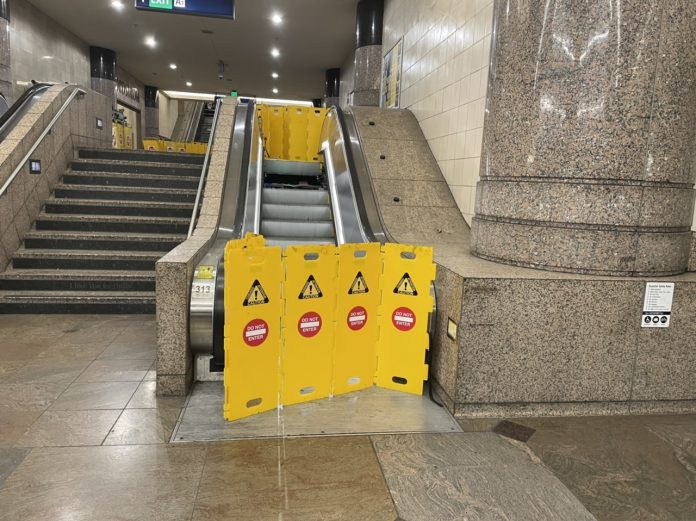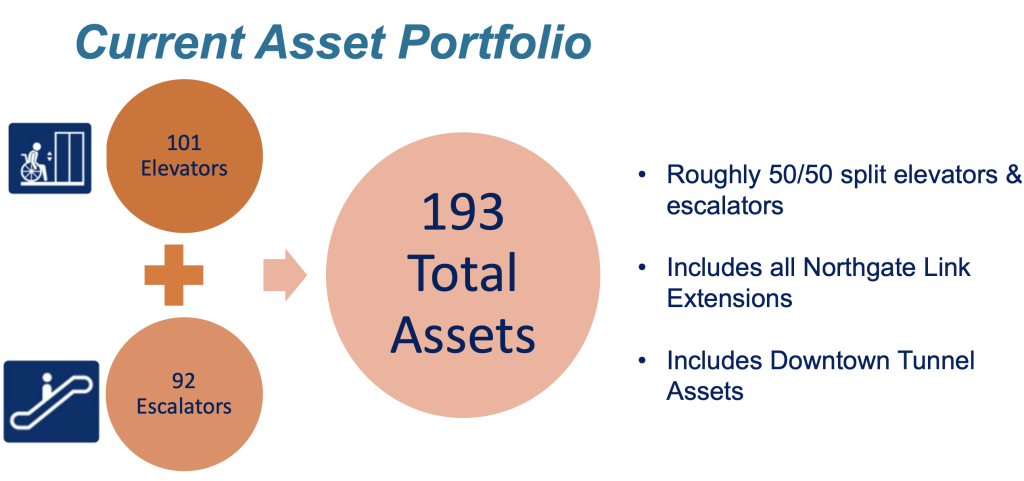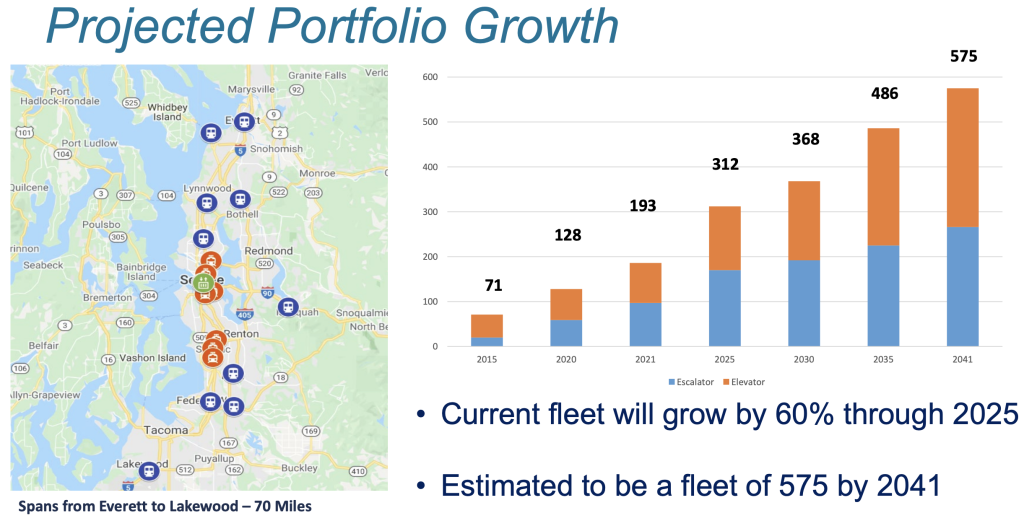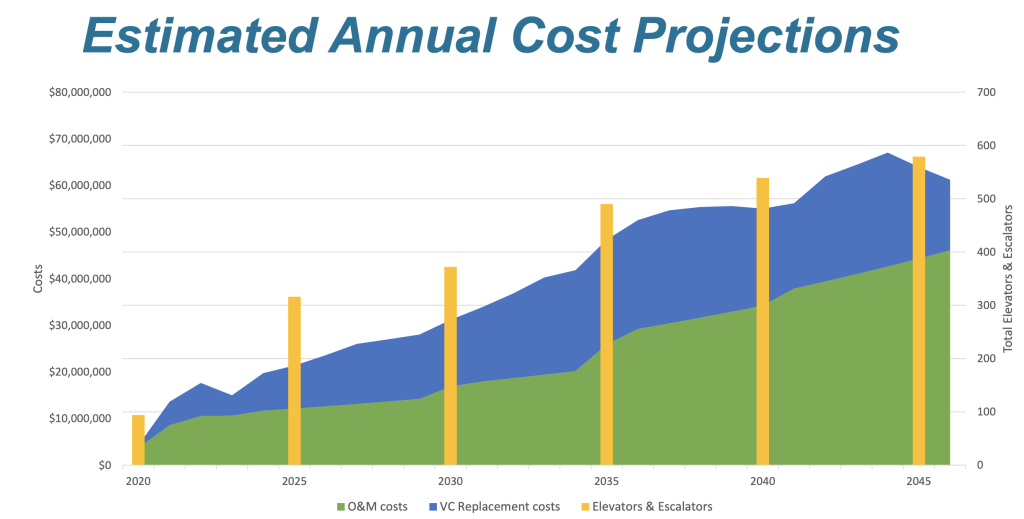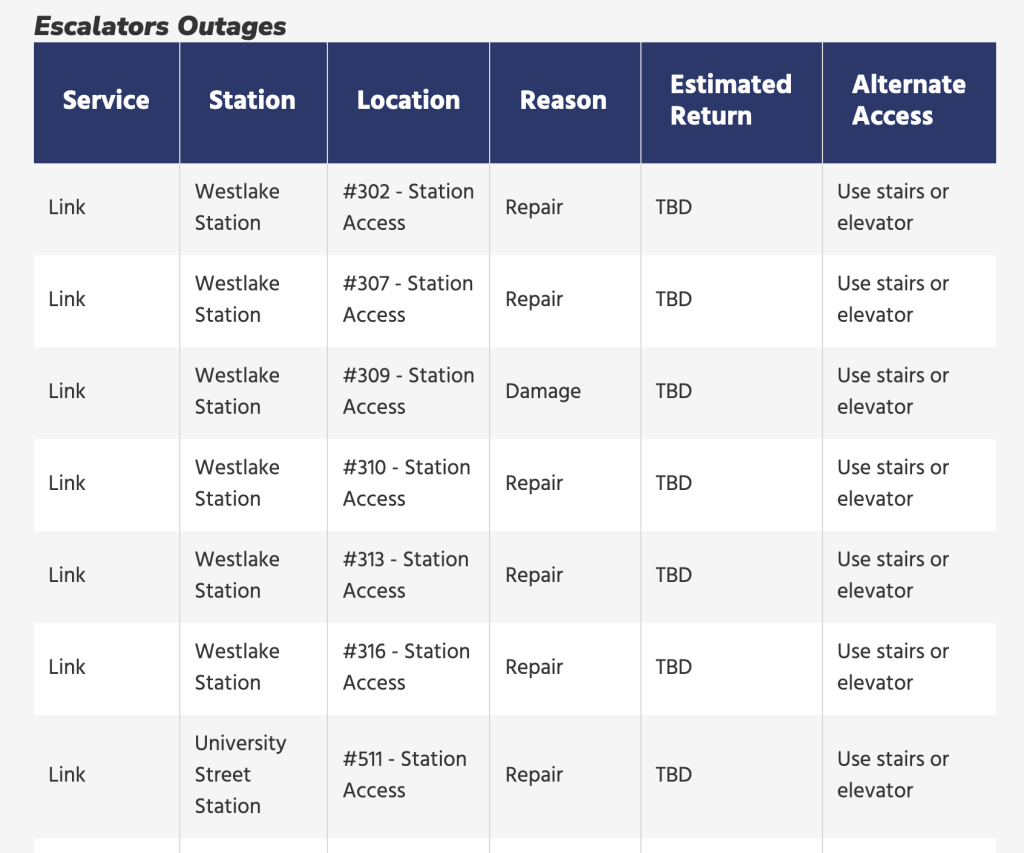Escalators and elevators are a persistent problem for Sound Transit. The agency has had constant troubles at newer facilities like Capitol Hill and University of Washington Stations, which led to opening emergency exit stairways and building out new ones for general use. Recently, routine outages have plagued the three new stations that opened as part of the Northgate Link extension in October, something that riders wouldn’t expect for brand new facilities. Perceptions have also grown worse because of King County Metro’s unforgivably poor management of the Downtown Seattle Transit Tunnel stations, which the agency all but forsake. Until this year, Sound Transit hadn’t assumed responsibility of those stations despite being the principal operator of them since 2019. The agency, however, is trying to rebuild its image and trust with the public and improve its vast and growing network of vertical conveyances (i.e., escalators and elevators), but it’s going to take time.
A recent staff presentation to the Sound Transit board of directors walked through what the agency has been able accomplish in the past year, where things are headed, and changes in how the agency approaches vertical conveyance systems. The information offered was detailed but deeply sobering. Riders shouldn’t get too excited that things will get magically better overnight, but there is light on the horizon.
Context on escalators and elevators
It might not seem like a big deal, but Sound Transit now considers elevators and escalators to be a formal “mode” of transportation just like buses and trains. It’s a policy shift and, as an acknowledgement of them as a mode within the Sound Transit transportation universe, it means that they are treated with equal importance in planning, operations, and maintenance. That’s changed how they approached by the agency.
As a mode, Sound Transit has 193 pieces of vertical conveyance split almost evenly between escalators (92) and elevators (101). The number of vertical conveyances is expected to balloon as the light rail system expands. The agency projects that it will have 312 vertical conveyance pieces by 2025, 368 by 2030, 486 by 2035, and 575 by 2041. That’s a lot of equipment to manage and it’s going to become increasingly expensive to operate.
The agency has already expanded the in-house vertical conveyance team, growing from one staffer in 2019 to four today. Additional hires are still to come, and Sound Transit has also leaned on improved and expanded contracts with vendors to maintain equipment. In 2019, the agency improved their maintenance contracts and added better performance metrics, response times, and parts inventories to them.
As equipment ages and the system grows, Sound Transit expenditures for vertical conveyance systems are going to look a lot more like regular transit operation costs. Annual costs for operations will rise from several million dollars today to around $45 million per year in the mid-2040s. Replacement costs will also ramp up to the tens of millions of dollars per year in the 2030s and 2040s. So, the vertical conveyance mode will be a big cost factor for operations and capital investments, but it is an imperative one for system usability.
In terms of equipment availability, Sound Transit has set a 95% goal for all escalators and 97% goal for all elevators. That’s the minimum threshold for what percentage of time that they should be running with the other 3% to 5% being acceptable periods of outages and repair. Of course, the agency would like there be as few outages as possible and in a perfect world would have no downtime ever. The agency says that they did poll other peer transit agencies (WMATA, BART, and MARTA) for targets, which ranged from 90% to 100% availability goals. However, there is no exact industry standard that the agency is aware of.
Recent system expansion
John Carini, Sound Transit’s vertical conveyances deputy director, said that the Northgate Link extension meant that 28 new pieces of heavy duty vertical conveyances were added to the system just as part of the three new stations.
“We implemented the lessons learned from U Link, such as installing heavy duty escalators with more robust components to better handle our transit environment,” Carini said. “We’ve specified the elevator size, which has gone to what’s called a ‘C1,’ which increases capacity and actually has the ability to handle a fully horizontal gurney in the event of an emergency.”
Carini added that the agency has instituted redundancies in elevators so that there’s always a backup option. Escalator technology is better than before, too.
“All of the escalators in the Northgate Link extension have what’s called ‘escalator sleep mode,'” Carini said. “That when no passengers are using that piece of equipment, it actually slows down saving approximately 32% of the power. And it actually has sensors installed on both the top and bottom of the escalators that if a passenger approaches, it speeds up before that passenger enters that piece of equipment.”
Sound Transit has added this sleep mode feature as a standard specification, meaning that future transit projects will include it. However, the new escalators aren’t set to go into a deeper sleep mode — full stop — when no passengers are present as is found in transit systems elsewhere across the globe.
Escalators within the new stations were not procured uniformly from one manufacturer, which adds some complexity in management. Schindler escalators are used at U District and Roosevelt Stations while Mid-American escalators are used at Northgate Station. Under the terms of their contracts, Schindler provides direct maintenance and parts for its equipment and Mid-American does the same for its equipment during the warranty period.
So far, the new stations have not been meeting the 95% availability target (ranging from 93.21% to 94.80% availability in October). Sound Transit blames this on mechanical failures and misuse of equipment by riders.
“First, in the opening two weeks, we saw a number of mechanical outages, no new major repairs, but predominantly additional component adjustments as the equipment saw full loads of passengers for the first time,” the agency reported. “The good news on this front is that the number of mechanical outages began to taper down as we moved toward the end of the month and that pattern has continued thus far through November.”
Sound Transit also reported that in October they “had 25 events of passenger misuse…nearly all of which were on escalator equipment,” which “included riding on top of a handrail, jumping on a comb plate, luggage getting caught up and setting off a safety or just mischievous passengers hitting the emergency stop buttons.” The agency suggested that the 95% availability target would have been met had these incidents not occurred.
Nevertheless, most outages appear to have been short-lived, for now, and corrective work happening rapidly.
Taking over the tunnel equipment
Now that Sound Transit has taken over management of the Downtown Seattle Transit Tunnel (DSTT), the agency is responsible for maintaining the vertical conveyances. Unfortunately, the equipment that Metro left behind is in very bad shape and has reached end of life.
Carini said that Sound Transit has developed a three-pronged approach with Schindler, the agency’s vendor, to getting things back in order, though it’s taken a lot of work because of where things are at right now.
“Effort Number One is state of good repair and life extension investments, so basically get the equipment operable and safe for our passengers,” Carini said. “Once the equipment is operable and safe, we roll it into our second tier, which is our maintenance program to ensure that piece of equipment is getting maintained on a monthly basis. And then finally, we’re looking at strategically prioritizing replacement understanding that these assets are over 30 years old, they are at end of life and need to be replaced.”
In 2020, the agency’s board of directors approved $8.7 million to focus on just the first prong: state of good repair and life extension of assets in the DSTT. Another $3.6 million is proposed for the upcoming budget to continue work on this effort. Funding has allowed vendors to make repairs and replace components as needed, such as chains, doors, handrails, and gears.
Because of Sound Transit’s investments, the DSTT assets have begun to come back from the brink — though broken escalators remain a very serious problem. Data shows that operations of vertical conveyance assets has risen dramatically since January:
- Elevator availability has gone from 81.8% to 96.62%;
- Escalator availability has gone from 30.1% to 71.2%; and
- Inoperable units has gone from 28 (out of 58) to just eight.
Things are expected to continue improving over the next year and a half. Sound Transit believes it’s possible for DSTT escalators to reach 95% availability by the middle of 2023. That’s based upon the performance of maintenance and repair work progress that has been made to date. The agency actually only set a goal of 70% escalator availability for the downtown stations by end of year, so perhaps that timeline could shorten if progress persists at a faster clip.
Long-term, however, Sound Transit is planning full replacement of the DSTT vertical conveyance equipment, which requires careful planning. Just to manufacture equipment requires a long lead time of “about 42 to 52 weeks from contract acceptance,” Carini said, and those timelines are on the rise due to pandemic impacts. The process of physical replacement also requires careful consideration because a unit will likely be out of service for an extended period of time (about three to five months) and, in some cases, could necessitate operating single-track for a few weeks or closing a station. So strategically replacing equipment so as to cause as little disruption possible to riders is an important part of the planning process even though it may seem like contractors should just get into stations tomorrow and start replacing everything.
Sound Transit has started the process to design for replacement equipment. International District/Chinatown Station design work has already been completed and the agency has moved onto design work for Pioneer Square and University Street Stations.
The first batch of new DSTT units is expected to go to bid next year. Conceivably, that could mean that the first units to be replaced could happen by the end of 2023 or early 2024. But the road will be long as Sound Transit doesn’t anticipate full replacement of DSTT to be completed until 2031, though various factors could either lengthen or shorten that window. Specifically, the agency says that labor is a key determinant here since there must be “labor availability to actually conduct this work as there are only a finite amount of vendors that can conduct this work as well a limited amount of labor.”
In total, 57 of 58 escalators will be replaced in the tunnel. That’s because one of the units was already modernized in 2008.
Other practices to keep equipment running and instill rider confidence
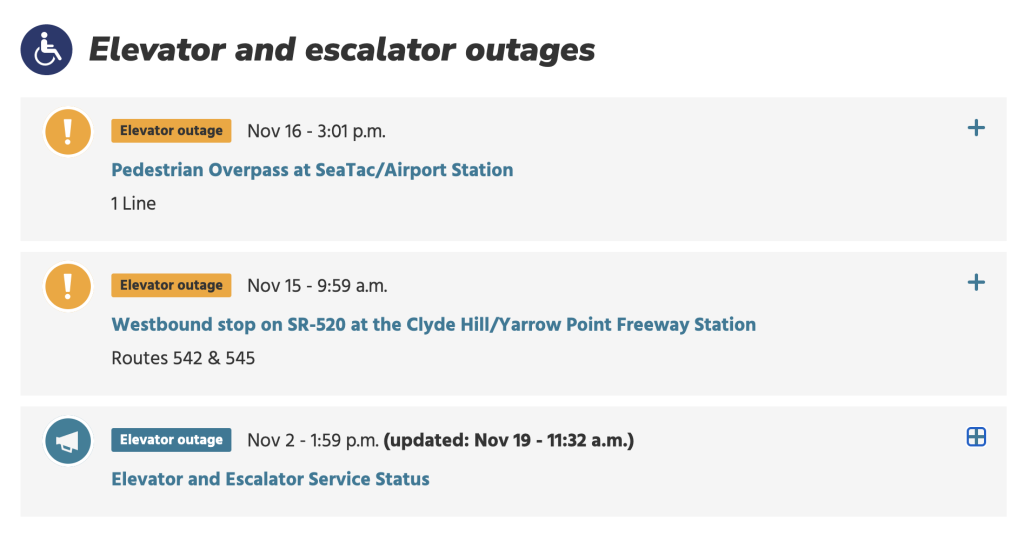
As inconvenient as equipment outages are, Sound Transit does offer riders some additional information on them.
The agency’s website provides notices of outages and a full list of them, the latter of which is updated every 24 hours on non-holiday weekdays. So riders using the website may find it to be out of date quickly, especially on weekends. The notices indicate the locations of outages and statuses; however, the location information won’t mean much to the average person since the locations within stations are numbered with no corresponding map. The estimated return to service information is also largely unhelpful to riders, usually offering only “to be determined” notes.
At stations, Sound Transit posts signs at the start of escalators in some cases, usually to indicate where riders can navigate to alternative vertical conveyances. But unlike other transit agencies across the globe, Sound Transit rarely places a direct estimate of when equipment will be repaired, except for what the agency considers long-term outages.
Riders can also subscribe to SMS/text alerts, but that seems vexing and bound to be ignored by the average person.
Overall, the agency’s communications on vertical conveyance outages is underwhelming and does not instill much rider confidence. Ideally, the agency would enhance the ways it communicates outages with like:
- Posting signs on equipment with estimates for short-term and long-term outages;
- Providing notices via in-station digital signage and audio alerts;
- Providing notices via digital screens onboard trains for next stops; and
- Pushing out alerts to third-party apps like Transit and Google Maps.
All of the information should be provided in real-time with little delay.
Perhaps with the forthcoming passenger information management system and integrated alerts system some of these possible enhancements will be realized, but for now riders are left to simply expect that their journeys will be disrupted in some way by escalator and elevator outages. That leaves many riders feeling very salty when Sound Transit has the power to assure riders that things are improving overall and instill greater rider confidence.
Stephen is a professional urban planner in Puget Sound with a passion for sustainable, livable, and diverse cities. He is especially interested in how policies, regulations, and programs can promote positive outcomes for communities. With stints in great cities like Bellingham and Cork, Stephen currently lives in Seattle. He primarily covers land use and transportation issues and has been with The Urbanist since 2014.

